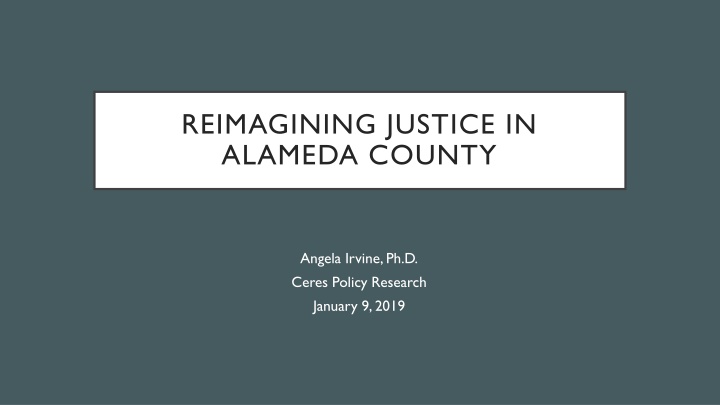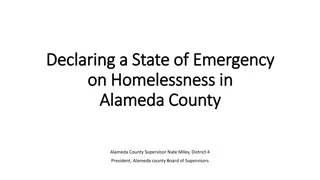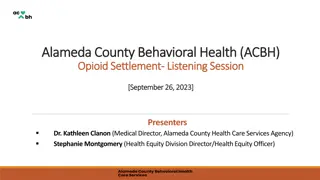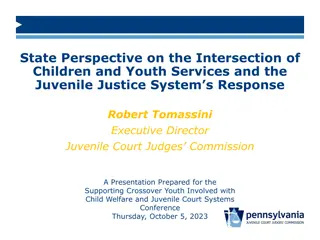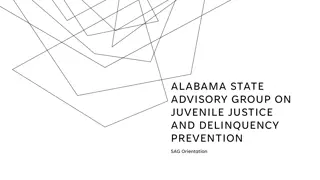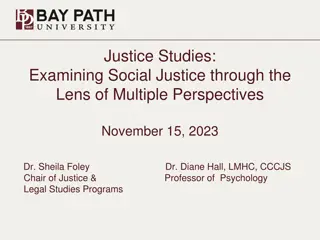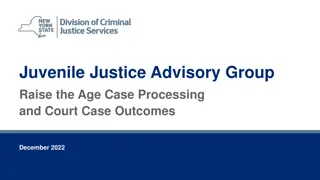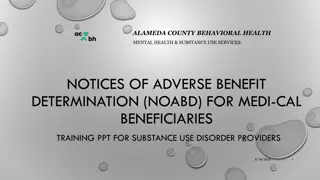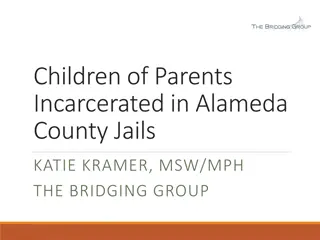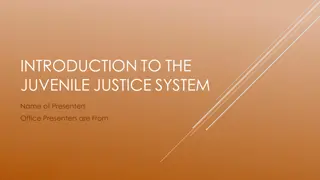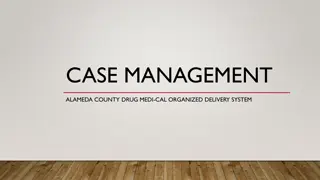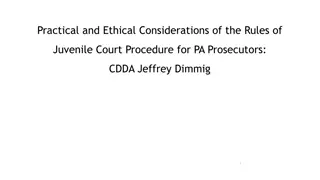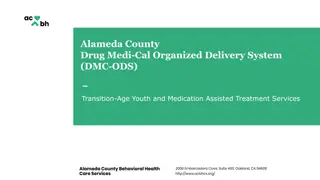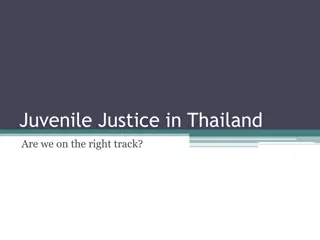Transforming Juvenile Justice in Alameda County
Reimagining justice in Alameda County involves reducing youth incarceration rates, addressing racial disparities, diverting non-violent crimes, and adopting a public health perspective on violent charges. Significant reductions in out-of-home placements and initiatives to reduce racial/ethnic disparities have shown positive outcomes in the justice system.
Download Presentation

Please find below an Image/Link to download the presentation.
The content on the website is provided AS IS for your information and personal use only. It may not be sold, licensed, or shared on other websites without obtaining consent from the author.If you encounter any issues during the download, it is possible that the publisher has removed the file from their server.
You are allowed to download the files provided on this website for personal or commercial use, subject to the condition that they are used lawfully. All files are the property of their respective owners.
The content on the website is provided AS IS for your information and personal use only. It may not be sold, licensed, or shared on other websites without obtaining consent from the author.
E N D
Presentation Transcript
REIMAGINING JUSTICE IN ALAMEDA COUNTY Angela Irvine, Ph.D. Ceres Policy Research January 9, 2019
Justice Reform Successes Youth incarceration has been reduced 41% across the country. California has seen even more dramatic improvements. We have gone from 10,000 youth in DJJ to just over 600. We have gone from 10,000 youth in county facilities to less than 4,000. See Davis et. al., 2014.
Ongoing Improvements to be Made At the same time: Racial and ethnic disparities continue 90% of incarcerated youth in California are Latino/-a, Black, Native American or have multiple racial/ethnic identities. See Irvine, Wilber, and Canfield, 2017.
Ongoing Improvements to be Made Up to 80% of youth in the California justice system are charged with non-serious, non-violent crimes. These are crimes that can, according to California law, be diverted by police prior to formal arrests. The additional 20% could be parsed and addressed differently from a public health perspective. See Countywide Criminal Justice Coordinating Council, 2017.
Public Health Perspective on Violent Charged Recent data analysis of assaults and robberies by Ceres Policy Research shows that among 150 violent crimes, there were 20 cases where there was a serious injury (stabbing, shooting, concussion, hospitalization, or multiple assailants), 22 cases where a firearm was used, 43 cases of grand theft, and 65 cases that DIDN T involve a serious injury, firearm, or grand theft. This leaves room to differentiate between the types of harm caused by crime and think creatively about restorative responses.
Alameda Placements 78% reduction in out-of-home placement 846 youth 2010-2013 compared with 140 youth 2014-2016. Irvine and Soto, 2018.
Reduction in Racial/Ethnic Disparities Irvine and Soto, 2018.
Magnitude of Change 2010-2013 402 cases not aligned with policy 256 cases unclear 2014-2016 46 cases not aligned with policy 59 cases unclear 105 cases in three years 35 cases per year Irvine and Soto, 2018.
Restorative Justice is More Effective Particularly with Violent Crimes baliga (2017) found that recidivism in Alameda County was significantly lower when restorative circles were used as a way to address violent crimes.
Community-Based Programs Are Also More Cost Effective The cost of incarceration is, on average, $240 a day. The cost of community programs is, on average, $75 per day. See Fazal, 2014.
Alameda Data Alameda arrested 1816 youth in 2016. 149 of these young people were charged with status offenses 852 of these youth were charged with misdemeanors 815 of these youth were charged with felonies. 42 of these felonies were drug charges 258 of these felonies were property felonies 350 of these felonies were violent/person charges See Center for Juvenile and Criminal Justice, 2018.
Alameda Data Added a different way: 1001 youth were arrested for status offenses and misdemeanors 300 youth were arrested for low to moderate level drug and property felonies 350 youth arrested for violent felonies See Center for Juvenile and Criminal Justice, 2018.
Alameda Data 34 of the youth charged with a misdemeanor were incarcerated 35 youth per year are placed in out-of-home placement for non-serious and non- violent crimes See Center for Juvenile and Criminal Justice, 2018 and Irvine and Soto, 2018.
Just Imagine The cost of sending 69 low to moderate level youth to ranch or group homes for an average of six months costs $3,000,000 per year. If we spent the same amount on community programs, we could: Spend $375,000 for short-term 3-5 day pre-arrest diversion programs for the 1001 youth charged with status offenses and misdemeanors $202,500 for 3-month weekly diversion programs for 75% (225) of the 300 youth charged with drug and property felonies. $1,080,000 for six-month intensive community programming that meets twice a week (diversion or post-adjudication) for 75 youth with drug and property felonies and 300 youth with violent felonies. $936,000 for stipends for youth in intensive community programming that equate to $13/hour for four hours of their time for each day of programming.
References baliga, s., Henry, S., & Valentine, G. (2017). Restorative Community Conferencing: A study of Community Works West's restorative justice youth diversion program in Alameda County. Oakland, CA: Impact Justice and Community Works West. CCJCC Youth Diversion Subcommittee & The Los Angeles County Chief Executive Office. (2017). A Roadmap for Advancing Youth Diversion in Los Angeles County. Los Angeles, CA: The County of Los Angeles. CJCJ. (2018). Juvenile Justice Practices in California by County. San Francisco, CA: Center for Juvenile and Criminal Justice. Davis, A., Irvine, A., & Ziedenberg, J. (2014). Stakeholders' Views on the Movement to Reduce Youth Incarceration. Oakland, CA: National Council on Crime and Delinquency. Fazal, S. M. (2014). Safely Home: Reducing youth incarceration and achieving positive youth outcomes for high and complex need youth through effective community-based programs.Washington, DC: Youth Advocate Programs Policy and Advocacy Center. Irvine, A., & Soto, D. (2018). Reducing Out-of-Home Placements in Alameda: Successes, Challenges and Lessons. Oakland, CA: Impact Justice. Irvine, A., Wilber, S., & Canfield, A. (2017). Lesbian, Gay, Bisexual, Questioning, and Gender Nonconforming Girls and Boys in the California Juvenile Justice System: A Practice Guide. Oakland, CA: Impact Justice and the National Center for Lesbian Rights.
